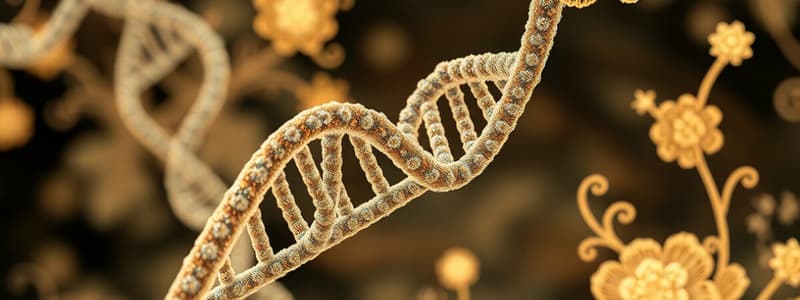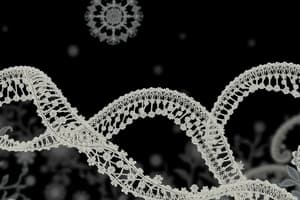Podcast
Questions and Answers
What is formed during bridge amplification in Illumina sequencing?
What is formed during bridge amplification in Illumina sequencing?
- Triple-stranded DNA structures
- Linear DNA molecules
- Double-stranded clonal bridges (correct)
- Single-stranded DNA fragments
Which component is NOT involved in the sequencing reaction of Illumina sequencing?
Which component is NOT involved in the sequencing reaction of Illumina sequencing?
- Primers
- Reverse strands (correct)
- DNA polymerase
- dNTPs labeled with a fluorescent dye
What is the purpose of the reversible terminator in Illumina sequencing reactions?
What is the purpose of the reversible terminator in Illumina sequencing reactions?
- To prevent the denaturation of DNA strands
- To ensure only one dNTP is incorporated in each cycle (correct)
- To facilitate the removal of fluorescent dye after imaging
- To allow the incorporation of all four dNTPs simultaneously
In what scenario is Sanger sequencing more preferable than NGS?
In what scenario is Sanger sequencing more preferable than NGS?
What happens to the fluorescent dye and terminator after imaging in Illumina sequencing?
What happens to the fluorescent dye and terminator after imaging in Illumina sequencing?
What is the purpose of the reversible termination in the nucleotide incorporation process?
What is the purpose of the reversible termination in the nucleotide incorporation process?
Which step involves breaking DNA into manageable fragments for Illumina sequencing?
Which step involves breaking DNA into manageable fragments for Illumina sequencing?
What feature is characteristic of the bridge PCR in Illumina sequencing?
What feature is characteristic of the bridge PCR in Illumina sequencing?
Which NGS technology uses pyrosequencing?
Which NGS technology uses pyrosequencing?
What happens to the DNA fragments that do not attach to the primers during the bridge amplification?
What happens to the DNA fragments that do not attach to the primers during the bridge amplification?
During the sequencing by synthesis process, what occurs after the incorporation of a single nucleotide?
During the sequencing by synthesis process, what occurs after the incorporation of a single nucleotide?
What is the primary purpose of library quantitation in Illumina sequencing?
What is the primary purpose of library quantitation in Illumina sequencing?
In which step of Illumina sequencing are short sequences of DNA adapters attached to the fragments?
In which step of Illumina sequencing are short sequences of DNA adapters attached to the fragments?
What was the duration and cost of the Human Genome Project?
What was the duration and cost of the Human Genome Project?
What are the two major categories of Next Generation Sequencing (NGS)?
What are the two major categories of Next Generation Sequencing (NGS)?
What major advantage does Next Generation Sequencing (NGS) offer over traditional sequencing methods?
What major advantage does Next Generation Sequencing (NGS) offer over traditional sequencing methods?
How has Next Generation Sequencing (NGS) impacted the cost of sequencing?
How has Next Generation Sequencing (NGS) impacted the cost of sequencing?
What application does RNA sequencing (RNA-seq) NOT typically assist with?
What application does RNA sequencing (RNA-seq) NOT typically assist with?
What technology is NOT a major method of NGS?
What technology is NOT a major method of NGS?
What role does sequencing by hybridization play in NGS?
What role does sequencing by hybridization play in NGS?
Which of the following is a key reason NGS has revolutionized biological sciences?
Which of the following is a key reason NGS has revolutionized biological sciences?
What is the function of adapter sequences in sample preparation?
What is the function of adapter sequences in sample preparation?
How is amplification achieved on sequencing machines?
How is amplification achieved on sequencing machines?
What does raw data from a sequencing run consist of?
What does raw data from a sequencing run consist of?
Which characteristic is NOT typical of Sequencing by Synthesis (SBS)?
Which characteristic is NOT typical of Sequencing by Synthesis (SBS)?
What is meant by 'massively parallel sequencing' in the context of SBS?
What is meant by 'massively parallel sequencing' in the context of SBS?
What is a significant drawback of Sequencing by Synthesis with respect to error rates?
What is a significant drawback of Sequencing by Synthesis with respect to error rates?
What does reversibly terminating nucleotides allow in the SBS process?
What does reversibly terminating nucleotides allow in the SBS process?
Why is higher sequence coverage desired in Sequencing by Synthesis?
Why is higher sequence coverage desired in Sequencing by Synthesis?
Study Notes
The Human Genome Project
- The Human Genome Project was the first major endeavor in DNA sequencing.
- It utilized first-generation sequencing, specifically Sanger Sequencing (Chain Termination method).
- The project lasted 13 years and cost $3 billion.
- It was completed in 2003.
Next Generation Sequencing (NGS)
- NGS is the next advancement in DNA sequencing technology.
- It is also known as Second-Generation Sequencing.
- It was introduced in 2004 and 2006.
- NGS offers high-throughput sequencing, meaning it can sequence many DNA fragments simultaneously.
Advantages of NGS
- NGS is a massively parallel sequencing technology.
- It provides ultra-high throughput, scalability, and speed.
- NGS is used to determine the order of nucleotides in:
- Entire genomes
- Targeted regions of DNA or RNA
NGS Impact
- NGS has revolutionized biological sciences, enabling various applications.
- It has significantly advanced genome sequencing due to its increased speed and accuracy.
- This leads to lower costs and reduced manpower requirements.
- NGS has decreased the cost per megabase of sequenced DNA.
- The number and variety of sequenced genomes have significantly increased.
NGS Applications
- Rapid sequencing of whole genomes
- Deep sequencing of target regions
- RNA sequencing (RNA-seq) to:
- Discover novel RNA variants and splice sites
- Quantify mRNAs for gene expression analysis
- Analyze epigenetic factors like:
- Genome-wide DNA methylation
- DNA-protein interactions
- Sequence cancer samples to study:
- Rare somatic variants
- Tumor subclones
- Identify novel pathogens
Categories of NGS
- Two main categories:
- Sequencing by Hybridization
- Utilizes specific probes to interrogate sequences.
- Used in diagnostic applications for:
- Identifying disease-related SNPs
- Identifying gross chromosome abnormalities like rearrangements, deletions, duplications, and copy number variants (CNVs)
- Sequencing by Synthesis (SBS)
- An advancement of Sanger sequencing without ddNTPs.
- Uses repeated synthesis cycles and methods to incorporate nucleotides into a growing chain.
- Sequencing by Hybridization
Similarities Between NGS Technologies
- Sample Preparation:
- Requires a library obtained through amplification or ligation with custom adapter sequences.
- Adapter sequences enable library hybridization to sequencing chips.
- They provide universal priming sites for sequencing primers.
- Sequencing Machines:
- Each library fragment is amplified on a solid surface (beads or flat silicon).
- This is done using covalently attached DNA linkers that hybridize library adapters.
- Amplification creates DNA clusters, each originating from a single library fragment.
- Each cluster acts as an individual sequencing reaction.
- The sequence from each cluster is read optically using light or fluorescence.
- Each machine has its specific cycling conditions.
- Data Output:
- Each machine provides raw data at the end of the sequencing run.
- Raw data is a collection of DNA sequences generated at each cluster.
- This data is further analyzed to provide meaningful results.
Sequencing by Synthesis (SBS) Properties
- Relies on shorter reads (300-500 bp).
- Generally has a higher error rate compared to Sanger sequencing.
- This is due to incomplete removal of fluorescent signals, leading to increased background noise.
- Relies on high sequence coverage, known as "massively parallel sequencing."
- This involves sequencing millions to billions of short DNA sequence reads (50-300 nucleotides).
- This is also referred to as Short Read Sequencing.
- Utilizes step-by-step incorporation of reversibly fluorescent and terminated nucleotides.
- Nucleotides are modified in two ways:
- Each nucleotide is reversibly attached to a single fluorescent molecule with unique emission wavelengths.
- Each nucleotide is also reversibly terminated, ensuring only one nucleotide is incorporated per cycle.
- Nucleotides are modified in two ways:
Sequencing by Synthesis (SBS) Process
- All four nucleotides are added to the sequencing chip.
- A single nucleotide is incorporated into the sequence.
- Remaining nucleotides are washed away.
- The fluorescent signal is read at each cluster and recorded.
- Both the fluorescent molecule and terminator group are cleaved and washed away.
- The process repeats until sequencing is complete.
NGS Technologies
- 454 sequencing or pyrosequencing (Roche Applied Science)
- Solexa Technology (Used in Illumina genome analyzer)
- The SOLiD platform (Applied biosystems)
- Ion Torrent: Proton/PGM sequencing
- The HeliScope Single Molecule Sequencer Technology
- SMRT Pacific Biosciences
Illumina (Solexa) Sequencing
- Overview (Cyclic Reversible Termination)
- Shin et al. 2014
Illumina Sequencing – Step 1: Library Preparation
- DNA is broken into smaller, manageable fragments (~200-600 bp).
- Short sequences of DNA called adapters are attached to the DNA fragments.
- DNA fragments with adapters are denatured (made single-stranded).
- Libraries are constructed containing a mixture of adapter-flanked fragments up to several hundred bp in length.
Illumina Sequencing – Step 1: Library Preparation Summary
- DNA fragmentation
- Adaptor ligation
- Library quantitation
Illumina Sequencing – Step 2: Bridge Amplification
- Illumina technology relies on bridge PCR to amplify the genomic region for sequencing.
- An in vitro constructed adapter-flanked library is PCR amplified.
- Both primers densely coat the surface of a solid substrate, attached at their 5' end by a flexible linker.
- This ensures that the amplification products remain locally attached near the point of origin.
- At the end of PCR, each clonal cluster contains ~1000 copies of a single member of the template library.
- DNA fragments with adapters are made single-stranded.
- Prepared DNA fragments are washed across the flow cell (sequencing chip).
- Complementary DNA binds to primers on the flow cell surface.
- Unbound DNA is washed away.
Illumina Sequencing – Step 2: Bridge Amplification
- The complementary strand of the DNA fragment in the library is synthesized.
- The complementary strand folds over and anneals with the other type of flow cell oligo, forming a bridge.
- The double-stranded bridge is denatured, creating two single strands attached to the flow cell.
- The process of bridge amplification repeats, forming more clones of double-stranded bridges.
Illumina Sequencing – Step 2: Bridge Amplification - Clonal Clustering
- Double-stranded clonal bridges are denatured.
- Reverse strands are removed.
- Forward strands remain as clusters for sequencing.
Illumina Sequencing – Step 3: Sequencing Reaction
- The components are:
- Primers
- dNTPs
- Labeled with a fluorescent dye.
- Contain a reversible terminator (Trinitrogen = N3)
- DNA polymerase
Illumina Sequencing – Step 3: Sequencing Reaction
- Cyclic reversible termination is used.
- Only one of the four fluorescent dNTPs is added per cycle.
- Images of clusters are captured after each nucleotide incorporation.
- After imaging, the fluorescent dye and terminator are cleaved and released.
Illumina Sequencing – Step 3
- The sequencing reaction uses fluorescent nucleotides with a reversible terminator group, Trinitrogen (N3).
When to Use NGS vs Sanger Sequencing
- Sanger sequencing:
- An appropriate choice for investigating a small region of DNA on a limited number of samples or genomic targets (~20 or fewer).
- NGS:
- Allows cost-effective screening of more samples.
- Enables the detection of multiple variants across targeted areas of the genome.
- Ideal when Sanger sequencing approaches would be too expensive and time-consuming.
Studying That Suits You
Use AI to generate personalized quizzes and flashcards to suit your learning preferences.
Related Documents
Description
This quiz explores the evolution of DNA sequencing from the Human Genome Project to Next Generation Sequencing (NGS). It covers the methods, advantages, and impact of these technologies on biological sciences. Test your knowledge on key developments and innovations in DNA sequencing.




